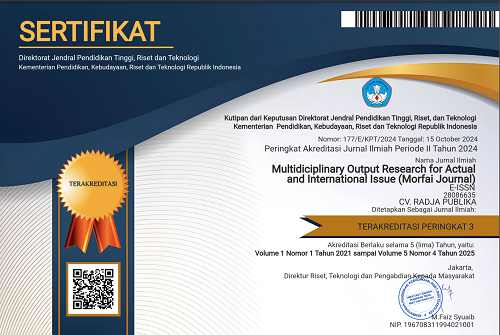PATTERNS OF CHEMICAL CONTROL OF WEEDS ON DISC ON PRODUCTION AND RAINFALL AND RAIN DAYS AT KUALA PESILAM GARDEN GARDEN ELEPHANT HALL DIVISION I PT. BAHRUNY
Main Article Content
Rina Maharany
Dina Arfianti Saragih
Delyana R Pulungan
Ika Ucha Pradifta
Muhammad Kahfi Adam
This final project research was conducted at the Kuala Pesilam Balai Gajah estate, Division I, PT. Bahruny, North Sumatra Province. This study took place from July to July 2021. This study aims to determine the pattern of weed control in the circle on production as well as rainfall and rainy days. This study uses a descriptive method by collecting secondary data from the garden: rainfall and production data. The results of this study can indicate that Indonesia's unstable palm oil production is caused by several factors, namely genetic factors, biotic factors (weeds) and abiotic factors (rainfall and rainy days). Production in 2020 is the highest production of oil palm for 4 years (2017-2020) with a total production of 5,971,760 Kilograms with an area of 336.96 hectares. The amount of rainfall is 2371 mm and rainy days is 117 days with weed control patterns on the disk carried out 4 times a year. Production in 2018 was the lowest production of oil palm for 4 years (2016-2020) with a total production of 4,032,338 kg, with an area of 267.96 Ha. The amount of rainfall is 1854 mm and rainy days is 112 rainy days with weed control patterns on the disc 2 times a year. The optimal rainfall for the growth and production of oil palm plants is 2,000 mm, but with 1846 mm of rainfall it does not mean it is not good for the growth and production of oil palm plants as long as there is no water deficit, so this rainfall is still included in the criteria for growing oil palm. Production in 2018 was the lowest production of oil palm for 4 years (2016-2020) with a total production of 4,032,338 kg, with an area of 267.96 Ha. The amount of rainfall is 1854 mm and rainy days is 112 rainy days with weed control patterns on the disc 2 times a year. The optimal rainfall for the growth and production of oil palm plants is 2,000 mm, but with 1846 mm of rainfall it does not mean it is not good for the growth and production of oil palm plants as long as there is no water deficit, so this rainfall is still included in the criteria for growing oil palm. Production in 2018 was the lowest production of oil palm for 4 years (2016-2020) with a total production of 4,032,338 kg, with an area of 267.96 Ha. The amount of rainfall is 1854 mm and rainy days is 112 rainy days with weed control patterns on the disc 2 times a year. The optimal rainfall for the growth and production of oil palm plants is 2,000 mm, but with 1846 mm of rainfall it does not mean it is not good for the growth and production of oil palm plants as long as there is no water deficit, so this rainfall is still included in the criteria for growing oil palm.
Gapki., 2020. Ngobrol Bareng Gapki Prediksi Kemarau 2020 Dan Dampaknya Bagi Perkebunan Kelapa Sawit.
Indriarta, A. Nabila., 2019. Kelapa Sawit : Budi daya dan pengolahannya. Loka Aksara. Tanggerang.
Nuvitarini, W., Zaman, S., dan Junaedi A. 2016. Pengelolaan Gulma Kelapa Sawit Studi Kasus Di Kalimatan Selatan : Bul. Agronomi 4(1) : 29-36.
Sarjono, B. Y. dan Zaman, S. 2017. Pengendalian Gulma pada Perkebunan KelapaSawit (Elaeis guineensisJacq.) di Kebun Bangun Koling. Bul. Agrohorti 5(3): 384–391.
Hartanto, (2011), Sukses Besar Budidaya Kelapa Sawit, Penerbit Citra Media, Yogyakarta.
Indriarta, A. Nabila., 2019. Kelapa Sawit : Budidaya dan pengolahannya. Loka Aksara. Tanggerang.
Raharja, Hanang Slamet. 2019. Budi Daya Tanaman Kelapa Sawit. Jakarta Barat : PT Sunda Kelapa Pustaka.









